Chapter 7: Radio (30629.0K) - McGraw-Hill
Chapter 7: Radio (30629.0K) - McGraw-Hill
Chapter 7: Radio (30629.0K) - McGraw-Hill
Create successful ePaper yourself
Turn your PDF publications into a flip-book with our unique Google optimized e-Paper software.
402 Part V Impact of the Mass Media<br />
represented by the state. Their purpose is to support the Marxist system and to achieve the<br />
goals of the state as expressed through the Communist Party. Recent history has shown<br />
the communist approach to the press works best in a closed society in which information<br />
is tightly controlled by the government. Once information is available from competing<br />
sources, people give little credibility to the official media.<br />
This fact was illustrated by events in Russia and Eastern Europe at the end of the 1980s.<br />
The British Broadcasting Corporation (BBC), Voice of America, CNN, <strong>Radio</strong> Liberty, and<br />
<strong>Radio</strong> Free Europe unraveled the Communist Party’s media monopoly. TV viewers in<br />
Eastern Europe saw Western TV shows beamed from West Germany or sent via satellite.<br />
Hollywood movies on videocassette were widely available. The people of Eastern Europe<br />
and Russia saw the shortcomings of their political and economic systems and clamored<br />
for change. As a result, the communist theory of the press has few proponents today.<br />
China, Cuba, and North Korea are about the only places where it can be found, and even<br />
in those countries the official version of the theory often bears little resemblance to the<br />
actual practices of the media. In short, the communist theory has been rendered obsolete<br />
by events.<br />
A more recent formulation is the developmental theory, which would fall more toward<br />
the authoritarian side of the spectrum. In this ideology, the government mobilizes the<br />
media to serve national goals in economic and social development. Information is considered<br />
a scarce natural resource and must be carefully managed by the government to<br />
achieve national goals. Some of the goals the media are expected to help achieve include<br />
political integration, literacy, economic self-sufficiency, and the eradication of disease.<br />
Until recently, many emerging countries espoused the developmental approach, but<br />
changing economic and political conditions have made it less prevalent. Many emerging<br />
countries, such as Brazil, Chile, and Pakistan, have replaced dictatorships with democracies,<br />
and democracies typically look with disfavor upon government control over the<br />
media. In addition, even in those countries where democracy has yet to appear, the government<br />
has either privatized the formerly state-run media or allowed competition from<br />
independent channels. Consequently, the government has less control over the flow of<br />
information and is less able to promote the developmental approach. All in all, the growth<br />
of democracy and the growing popularity of free marketplace economics have resulted in<br />
more countries endorsing the social responsibility approach.<br />
>> Control and Ownership of the Media<br />
One helpful way of distinguishing among the various media systems throughout the<br />
world is to classify them along the dimensions of (1) ownership and (2) control. Finnish<br />
Professor Osmo Wiio has developed a useful analysis scheme, presented in Figure 17–2.<br />
As can be seen, ownership can range from private to public (public ownership usually<br />
means some form of government ownership), and control can range from centralized to<br />
decentralized. Note that this typology is an oversimplification. In many countries, there<br />
are mixed media systems in which part of the broadcasting system is owned by the government<br />
and part by private interests. In some countries, the print media could be placed<br />
in one cell of the matrix and the broadcasting system in another. Nonetheless, this model is<br />
helpful for displaying some of the major differences among systems.<br />
In the upper-left cell are type A systems. These represent decentralized control and public<br />
ownership, a type best illustrated by the broadcasting systems in European countries<br />
such as France, Denmark, and Italy. Some of the broadcasting media are publicly owned,<br />
but no single political or special interest group can control their messages. In Great Britain,<br />
for example, the British Broadcasting Corporation is a government-chartered, publicly<br />
owned corporation that is relatively immune to government censorship and interference.<br />
Private broadcasting systems also operate in these countries.<br />
In the upper-right cell are type B systems. This arrangement is typical of communist or<br />
socialist countries in which the media are publicly owned and controlled by the dominant<br />
political party. China is an example.
















